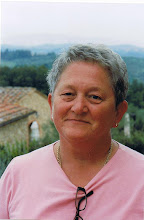Even though Marilyn will sorely miss her birdwatching in the wonderful park at the villa, we checked out of the country house hotel and packed the car with help from Antonia. It was a miracle that all of our bags did fit, but Antonio is a wizard at cramming stuff into a trunk.
We wended our way to Norcia, in the eastern part of Umbria, near the Sibillini mountain range and really close to Marche.
We checked into a very elegant hotel in town, which has abundant rooms on the ground floor to accommodate readers, chatters, diners, and spa-goers. Their goal is to make their clients feel at home. (My home certainly doesn't have such a beautiful library or such large, fireplaced living rooms, but these areas certainly were comfortable!)
Norcia is a small town, with about 3 parallel streets, 2 or 3 arched portals into town, a piazza, and a market on the outskirts, and maybe a small suburb. It's size reminds me of the town where I went to high school, but Wallkill, NY is actually larger.
April 25 is liberation (by the Americans) in Italy. Tis a big holiday. The whole town was out marching, going out to eat, and just enjoying the day off.
Wednesday afternoon, after a lunch in a very local restaurant, we were driven by Titziano to meet Nicola and his cute dogs so we could experience truffle hunting. We walked perhaps a good 2 miles in rocky fields and woods to get to Nicola's truffle field. There were lots of wild flowers, including, wild orchids.
It was a good hike; we all enjoyed getting out into the fresh air.
The dogs played during the walk, but as soon as we arrived at the appointed field, they started working.
 |
| The truffle is barely visible but it's there, at the end of the pointer. |
 |
| An unfocused truffle. |
 | |||||||
| The dogs find another one. |
Here's a photos of the view from his field. Beautiful.
And that was our truffle hunting.

















































